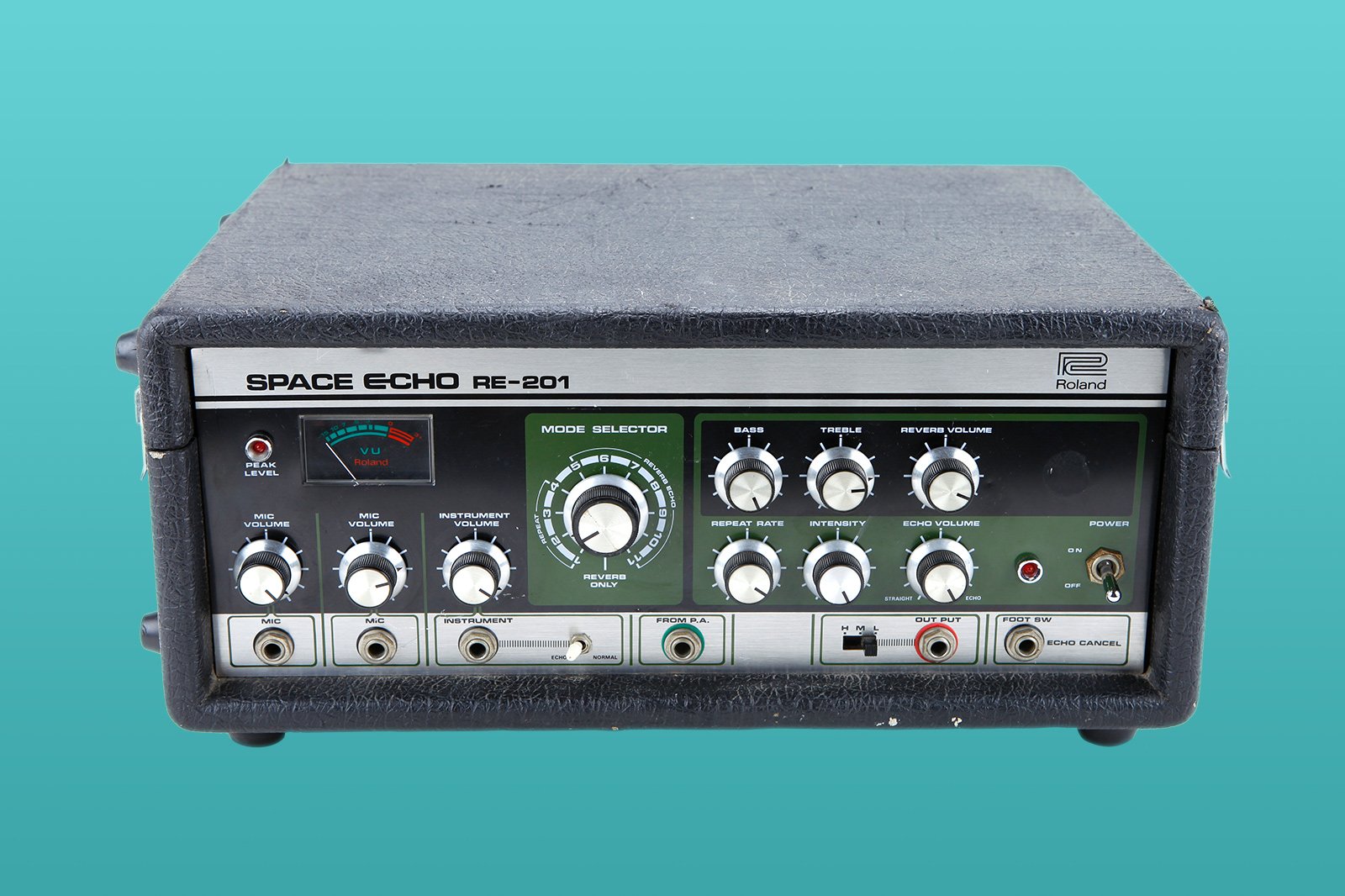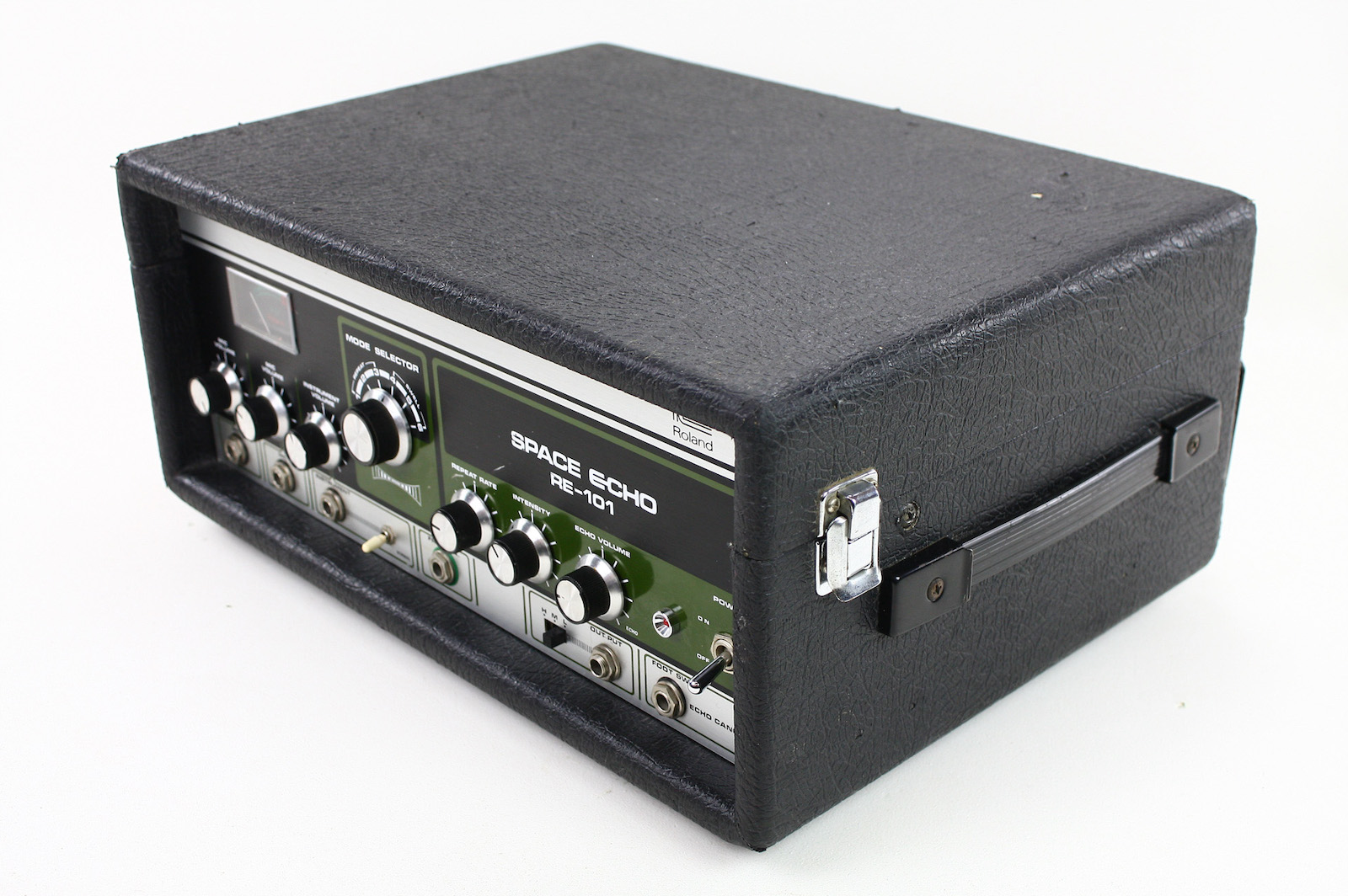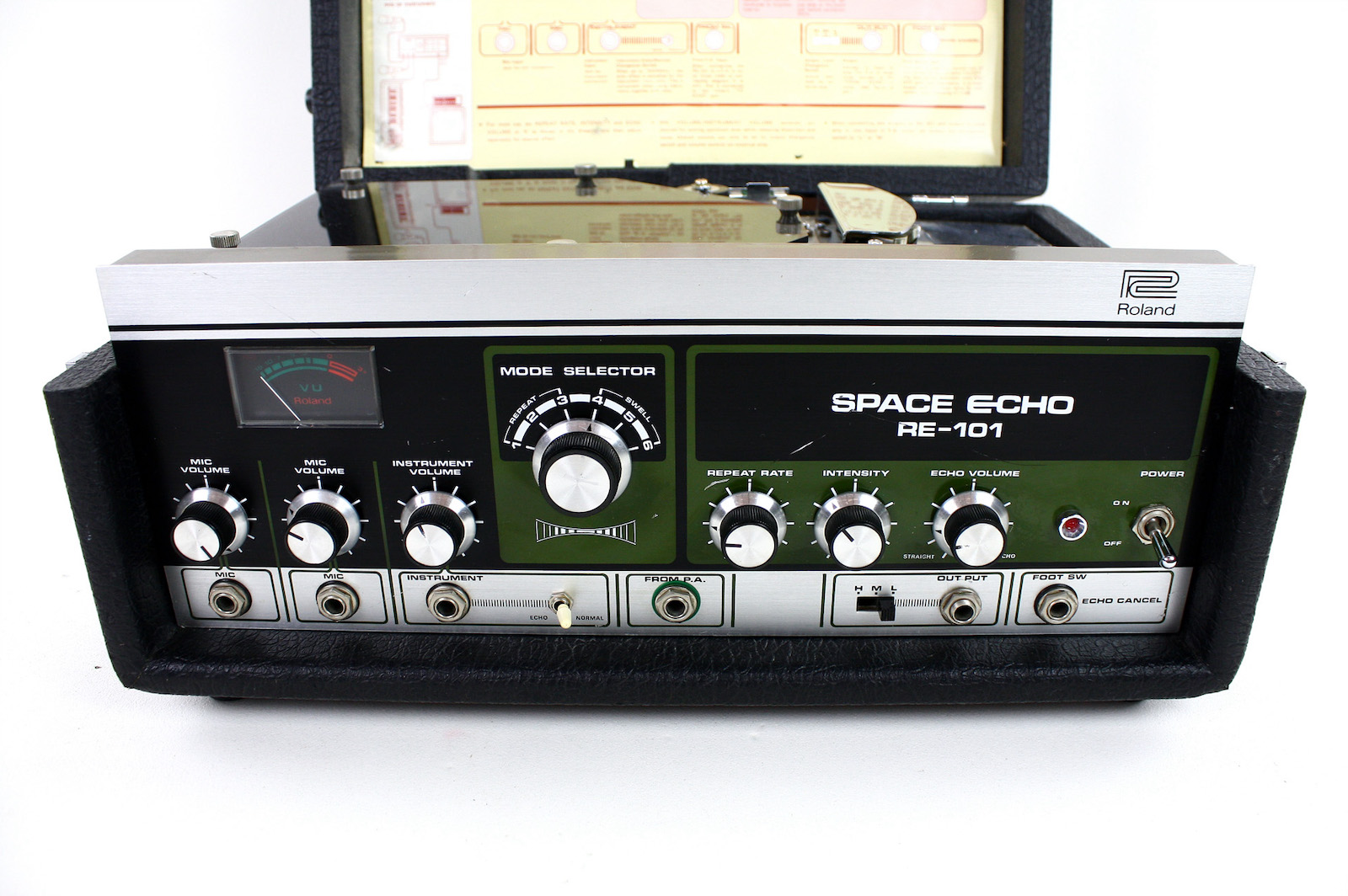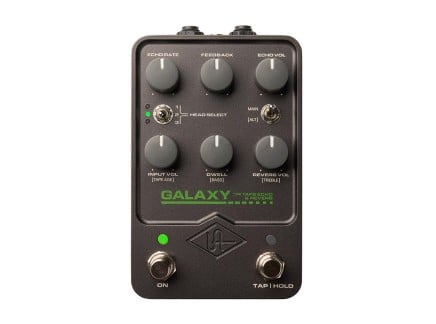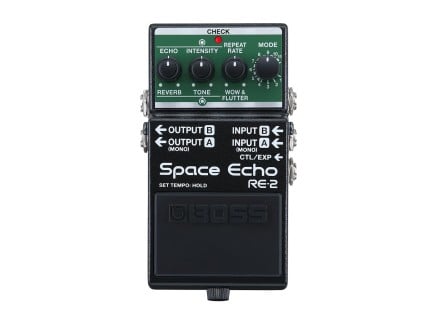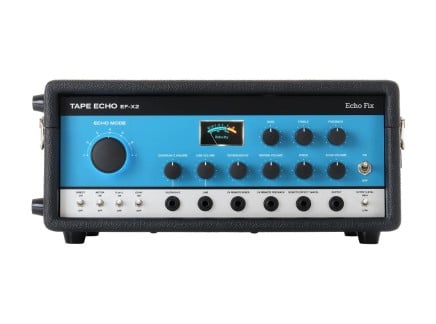Roland's Space Echo line is not only among the most beloved delay effects units ever made—they're some of the most desirable effects processors, period. Their delectable combination of tape delay, spring reverb, and a rich input preamp is a sonic combination that treats signals with beautiful enhancement. And then by cranking up the Intensity control, swelling feedback builds into an ethereal self-oscillation that can be used for beautiful special effects, further lending to the otherworldly sound inspiring the Space Echo name.
Compared to other well-known tape delay units, the various Space Echo models, especially the RE-201, boasted not only a characterful sound and sensible features but were also well-regarded for their reliability in the studio and on the road. In fact, their success during Roland's early days is a big contributing factor towards the company's continued influence and notoriety today. But for one reason or another, Space Echoes found their way into so many recording studios, where their sound has been immortalized in countless records over the past 50 years.
Today, the Roland Space Echo continues to command incredible influence over both new delay designs and the musical considerations that artists make when interacting with echo effects in their music. Many of us here at Perfect Circuit are avid fans of the Space Echo sound, and it continues to inspire our music. In this article, we want to take a trip back in time and look at how these mechanical wonders of delay and reverb effects were developed, compare the various models that were released, and ponder the reasons for their continued success and legacy.
Precursors: Analog Delays Before the Space Echo
A broader history of tape delay is beyond the scope of this article, but it's worth briefly looking back on some of the other comparable products that were available when the first Space Echo units hit the market. When Roland introduced their echo devices, many studios had already moved past repurposing reel-to-reel tape decks for special effects purposes, instead opting to invest in some of the first commercially-available devices that were dedicated to the task of delay.
Tape delay works on a simple operating principle for capturing sounds and playing them back at some point in the future. Using a recirculating loop of tape, sounds may be printed onto tape with a magnetic node, commonly referred to as a tape record head. After traveling a short distance, sounds are then read off of one or more playheads—delayed in time from the point at which they were recorded. The amount of delay time depends on both the physical distance between heads as well as the speed at which the tape is moving.
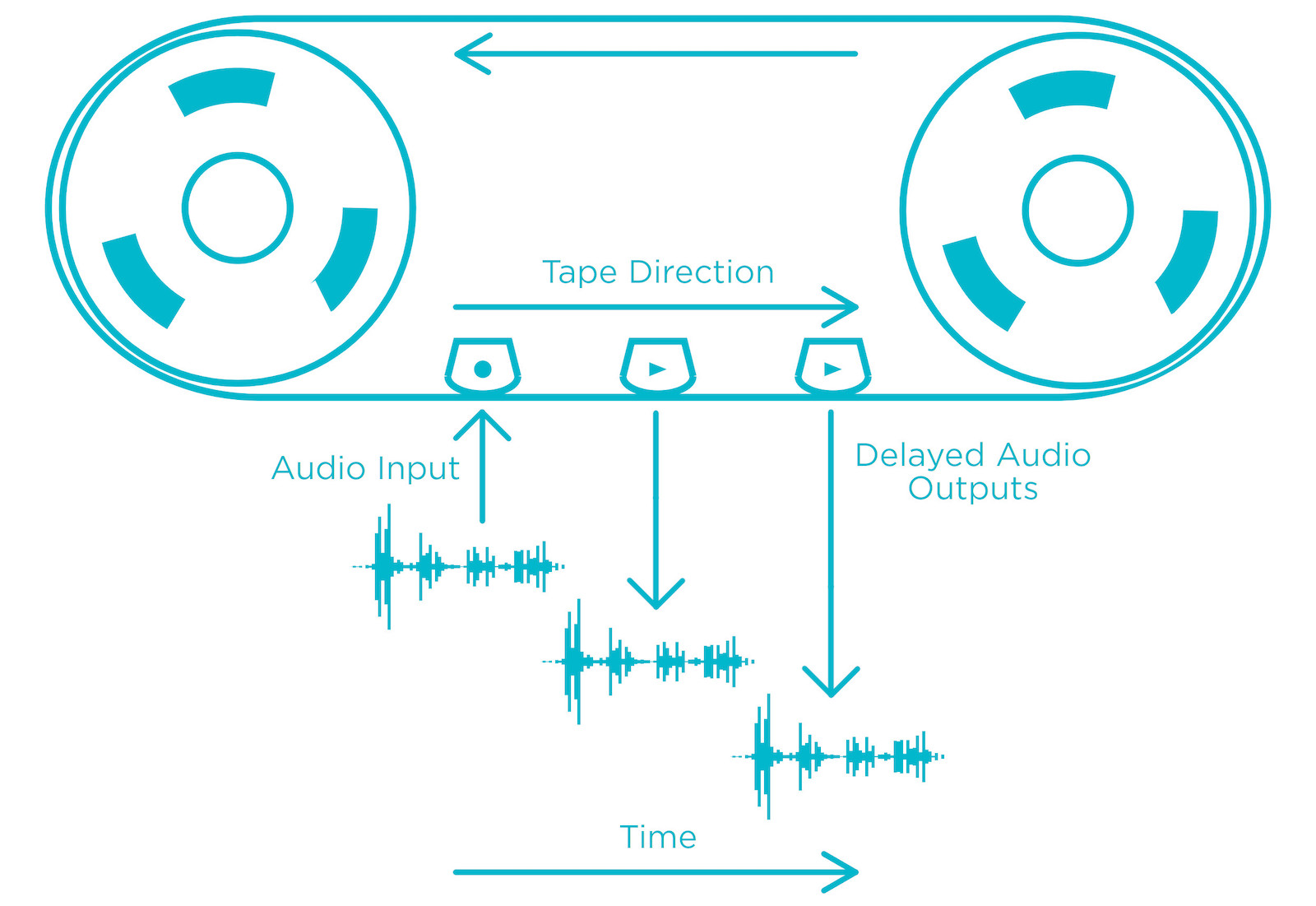
Feedback, or Intensity as it is called on some vintage units like the Space Echo, could be achieved by blending the delayed signal with any signals coming to the recording head. Rather than a single echo, this allows for long, cascading trails of repeats. And to prevent erroneous and undesired repeats, an erase head is used to clear sounds off of the tape before returning to the recording head, allowing for a precise amount of Feedback to be achieved with a variable control on the front panel.
By the early 1970s, there were a number of different devices available, but if one were to make a list of the top three most famous vintage analog delay units, it would likely consist of the Maestro Echoplex, the Binson Echorec, and, of course, the Roland Space Echo.
Considered to be the other most famous tape delay, the Echoplex gained popularity throughout the 1960s and '70s. Its design centers around a movable tape head, where the position determines how long or short the delay time is. Though it saw many iterations from earlier tube-based models to the famous solid-state EP-3 and beyond, the central tape delay mechanism and signature Echoplex sound remained consistent throughout. It was this sound that attracted legendary guitarists such as Jimmy Page and Brian May, who, among others, integrated the Echoplex into their studios and live performances.
On the other end of the spectrum, the Binson Echorec design didn't utilize tape at all! Instead, it would record and playback sound from a rotating magnetic drum, giving the Echorec a much different sound compared to either the Echoplex or Space Echo. Though the Echorec was less flexible in terms of establishing varying delay times, it did offer multiple modes and playback heads. By combining these features, it was possible to coax not only different delay times out of the Echorec, but also a wide range of smeared textures—used to great effect by David Gilmour and Richard Wright of Pink Floyd.
The Space Echo line was among Roland's earliest products, but it could actually be seen as a continuation of earlier tape echoes by founder and engineer Ikutaro Kakehashi. His prior company, Ace Tone, produced Echo Chamber units such as the EC-1 and EC-10 that looked vaguely similar to the first Space Echo models. However, as we can assume based on the topic of this article, Ace Tone eventually ceased production and transitioned into the Roland Corporation by 1973, which was when the first Space Echo models hit the market.

Of course, the devices listed above weren't the only tape delay devices that ever existed, but they're certainly among the most notable and influential to exist prior to the introduction of the Space Echo.
Why is the Roland Space Echo So Special?
Clearly, there's something about the Roland Space Echo—something that drew so many musicians, engineers, and producers across different genres to be captivated by its sound. Even today, when so many other delay and reverb technologies have been pioneered to create effects that couldn't have been imagined when the Space Echo was developed over 50 years ago, the Space Echo is still held in high esteem among delay aficionados. So, what is it about the Space Echo that gives it so much appeal?
At first glance, you might think that aside from the aesthetic differences, the Space Echo doesn't seem all that different from the Echoplex (or any other tape delay). They're all tape delays, so how different could they be?
Compared to the single movable playhead design of the Echoplex, the Space Echo offers multiple tapeheads for playback as well as a variable Rate control. Though the position and distance between the Space Echo's playheads are fixed, by using both the Mode switch to activate different playheads and the Rate knob to change the speed of the moving tape, it's possible to get both a variable range of delay times and different musical rhythms through the available combinations of tape heads.
 Chart from the RE-201 User Manual depicting the 12 modes available and their unique combinations of playheads and/or spring reverb
Chart from the RE-201 User Manual depicting the 12 modes available and their unique combinations of playheads and/or spring reverb
Most models, such as the RE-201, feature three playheads positioned such that anything from slapback echoes to longer delay phrases were possible. Bear in mind that without tap tempo or anything, delay times are dialed in manually with the Rate control, so a reasonable amount of musical relativity is at play with regards to tempo and delay time. I typically think of the first playhead as a "sixteenth note" rhythm, while the second is an eighth note and the third a slower triplet feel. Then, by selecting modes that combine them in different ways, stacking the first and second playheads leads to a more dense buildup of repeats, while combining either or both with the third playhead provides scattering rhythms degrading into a wash of tape delay texture.
While the tape delay is likely the first thing that anyone thinks of when the Space Echo comes to mind, there's actually so much more going into the magic of these machines. Of course, the tape certainly plays a big part in the Space Echo sound, but it's really the combination of tape with the preamp and spring reverb that brings the whole package together. Think about your favorite meals—there might be a prominent base ingredient, but it's the combination of other flavors, seasonings, and preparation that elevates the experience beyond just eating raw ingredients together. Indeed, the union of tape, preamp, and spring reverb together was the perfect combination of elements to give the Space Echo its sonic allure. Some later units would also add an analog BBD chorus for further dimension, but for many this is viewed as a bonus rather than a core feature necessary for the Space Echo sound.
Most Space Echo models feature three preamp inputs: two 1/4" microphone inputs and one instrument input, so it's possible to feed a number of sources into the unit for simultaneous processing. Some later models would offer XLR inputs for the convenience of using mics without adapters or other balanced signal sources, but in general, the type of input offers a clue as to its expected signal level. For creative purposes, this can inform your input choice depending on the amount of desired saturation. In my opinion, a big part of the Space Echo's secret sauce comes from driving the preamps harder, giving signals a bit of color before they hit the tape delay. Tape saturation is its own thing, but the preamps that Roland packed into these are something special, especially when used on vocals or guitars.
Though it seems like the least flexible component of the Space Echo signal chain, don't be so quick to dismiss the importance of the spring reverb. The music world was no stranger to the humble spring reverb tank by the time of the Space Echo's release—they were commonly installed into guitar amps, notably Fender's Twin Reverb and Deluxe Reverb models. Few would consider a spring tank to offer a very convincing or realistic type of reverb. However, its drippy and distant sound provides a particularly musical color complementing not only guitars but also drums, vocals, and other instruments quite well.
On the Space Echo models which contain a spring reverb, you'll find a dedicated Reverb Volume control on the front panel. For later models, this is the only control for the reverb. For others, the spring can also be bypassed entirely in certain "Repeat" only modes—conversely, the tape delay itself can be bypassed in the "Reverb Only" mode, usually found at the very bottom of the rotary Mode switch.
Crucially, perhaps above everything else, there's something about the physical design of the Space Echo that sets it apart from every other mechanically-operating delay. Don't get us wrong, both the Echoplex and the Echorec are magnificent devices with gorgeous, unique sounds. However, both devices are infamous for their maintenance needs and potential unreliability on the road. Remember, this was before even BBD delay pedals existed, and this was a time when it was becoming an expectation for musicians to be able to recreate their studio recordings on stage to the best of their abilities. It's very likely that this growing need was a strong consideration for Roland while developing the Space Echo design, so it's no surprise that not long after their release that Space Echoes began to appear not only in studios but on stages, too.

Beginning with their seminal RE-201, Roland's engineering prowess was demonstrated with a new system for hosting tape. Unlike prior units with a short, fixed-length loop of tape put under continuous stress and strain, their new system utilized a tape chamber that stores the excess length of a much longer loop. This freely-moving tape then is pulled through to the mechanical transport by a single capstan motor. Fewer points of stress and a physically longer supply of tape both contribute to a greater extension of tape life and reduced risk of failure or tape breakage. It seems simple, but it's incredibly effective for improved reliability and arguably lends a positive effect to the sound of these machines.
Space Echo Tape Delay Timeline
Once Roland picked up the torch from Ikutaro Kakehashi's prior company Ace Tone, Space Echoes were available for purchase right from the beginning. And for nearly the first 20 years of their existence as a company, some variant of the Space Echo was listed in Roland's product catalog. Now, we'd like to run down the different tape-based Space Echo models Roland produced between 1973 and the early 90s—a few digital spin-offs occurred towards the end, but for the purposes of this article, we'll stick to the analog tape machines.
RE-100 and RE-200
The first official Space Echo models from the fledgling Roland Corporation, the RE-100 and RE-200 were effectively continuations of the Ace Tone Echo Chamber units. However, these models were a significant step towards what we now identify as a Space Echo—not just in name, but both sonically and visually.
Even without the signature black and green panel, this is the first time the complete Space Echo package came together. We can actually look at the RE-200 and identify all of the key ingredients that make up the Space Echo sound: preamp, tape delay, and spring reverb. As a more affordable option, the RE-100 omitted the spring tank and featured a simpler arrangement of playback heads. On both models, their tape transport used the older design with a shorter loop of tape, but they did introduce the separate Treble and Bass EQ controls as well as, in the case of the RE-200, the spring reverb. Interestingly, the RE-100 featured the two-band EQ as well, though this would be removed on subsequent budget models.
Due to their use of the older tape system, these models were quickly cast aside by newer, improved versions just a year later. But the RE-100 and RE-200 were just a hint as to what was to come from their successors.
RE-101 and RE-201
Realizing that improvements could be made, Roland quickly iterated upon the first Space Echo models. With the resulting RE-101 and RE-201 released in 1974, Roland struck gold and cemented the Space Echo line into the music effects hall of fame. Of course, the main difference introduced with these new models was the new free-running tape design, but they also introduced the signature green and black aesthetic that the Space Echo series has become known for.
The RE-201 was the first true flagship model of the Space Echo series, containing the entire signal path that would become the signature sound associated with this line of products. In some ways, the RE-201 was the most open-ended of all Space Echo models. Its 12-position Mode switch offered any possible combination of the three playheads and spring reverb, directly enabling or bypassing sections as needed to preserve knob positions for levels and other paremeters. The three-channel input preamp could be used to blend a few sources before heading into the delay and reverb—the instrument channel could even bypass the echo if effects were only desired on the microphone inputs. Alternatively, the PA input facilitated wet-only effects output in conjunction with an external mixer, bypassing the Space Echo preamps and allowing input and auxiliary send levels to be established with each mixer channel.
By comparison, the RE-101 was slightly stripped back, omitting the spring reverb, EQ, and providing a simplified selection of playhead combinations. It still featured three playback heads but offered six modes split into single Repeat and feedback-capable Swell modes. The latter modes could produce the cascading rhythmic textures that would become a hallmark of the Space Echo sound, while the former modes were more utilitarian due to the bypassed feedback path.
Though even flashier versions would be produced in the years to come, the success of the RE-201 ensured that it would be the benchmark for all future models. Even when seemingly succeeded by enhanced and improved models, it was the RE-201 that stood out from the rest and so perfectly established what these machines are all about. And despite the higher price compared to cheaper models, the RE-201 attracted tons of musicians and engineers with its otherworldly echoes and characterful sound—the fact that this model was in production for nearly 20 years from 1974 to 1990 says a lot about its enduring appeal. Even today, nearly 50 years after its introduction, when anyone thinks of the sound of the Space Echo, they're probably thinking of the RE-201.
RE-150
Like the RE-101, the RE-150 was another streamlined and more affordable alternative to the flagship RE-201. It also foregoes the spring reverb and two-band EQ for a more straightforward preamp and tape delay design. However, the RE-150 offers some slightly unique features compared to other models.
Though it only offers two playheads compared to the three found on every other model, the RE-150 still features a six-position rotary switch for mode selection. Like the RE-101, the RE-150 offers Single and Repeat modes, though with only two heads the difference is purely in whether or not the feedback path is enabled. As such, the delay rhythms that it has available are a bit more limited and musically linear, but this is nothing that can't be rectified with multiple takes using different settings.
The RE-150 also features separate dry and wet outputs, which affords some more routing and recording opportunities unique to this model. In all other versions of the Space Echo, besides modifications or tricks with the normalization of the P.A. input on other models, the preamp-colored echo and reverb signals are always blended with the dry signal. While this is useful for inline effects processing, there are situations where a fully wet delay with some harmonic color from the preamps is desirable. The RE-150 makes this easily possible.
Author's note: the RE-150 is the model that I personally own. While I sometimes wish it had the spring reverb, for me it's nothing that can't be added or emulated with a pedal or plugin within a DAW. Speaking of DAWs, the largest reason I chose this model is because of those separate dry and wet outputs, so the "Echo Only" output is incredibly handy for using the Space Echo as an external effects return. The combination of the slightly pushed preamp and tape delay oozes sonic character that I really enjoy. I'll often set mine in single repeat mode, print some tracks through it, and nudge the recording back in time to blend with or replace the source signal.
RE-301
Despite the success of the RE-201, Roland would not have been satisfied to consider the Space Echo series complete so quickly. With their engineering teams juggling multiple projects in the late 1970s, we're certain that a number of different ideas could have been floating around behind the scenes. Finally, after a few years, Roland presented their next echo effects unit: the RE-301.
The notable addition of the RE-301 is the inclusion of an analog chorus, implemented with bucket brigade device (BBD for short) circuitry. BBDs are themselves a type of delay in the form of an integrated circuit—internally, signals are quickly passed down a line of capacitors, much as a fire brigade would pass buckets of water along (hence the name of the technology). Depending on the number of stages and the rate at which signals move through the BBD, a variety of different delay effects are possible, and eventually, BBD-based delay pedals offered a compact alternative to tape units. But in the early days of this technology, delay times were short enough to feel nearly instantaneous, and Roland realized that by subtly modulating the rate of this short delay with a low-frequency oscillator, it was possible to create the lush detuning effects that came to be associated with chorus effects.
Roland had developed BBD tech to be incorporated into their Jazz Chorus guitar amplifiers: a luscious, modulated sound that would soon spin off into key early products by Roland's effects division BOSS, namely the CE-1 Chorus Ensemble pedal. After investing plenty of time and energy into designing BBD circuits, it's no surprise that Roland would think to include it in a Space Echo. In fact, Roland deviated from the Space Echo name on the RE-301, dubbing this model the Chorus Echo as an obvious nod to its main difference.
Additionally, the RE-301 introduced a new feature known as Sound on Sound to produce even longer delays. Though the name has taken on a slightly different meaning these days when it comes to endless or slowly decaying overdubs, this version of Sound on Sound can be thought of more as a much longer delay compared to the typical settings. This mode features its own playhead and bypass switch, allowing it to be engaged regardless of how the rest of the Chorus Echo is being used.
RE-501 + SRE-555
By the beginning of the 1980s, technological advancements foreshadowed a digital revolution that would soon be taking place. However, Roland was not quite done with their analog Space Echo units just yet. Though it departs from the black and green aesthetic for the striking black and orange look found on Roland products like the Jupiter-8, the RE-501 is still a key member of the Space Echo family.
Largely the same machine as the RE-301, the RE-501 Chorus Echo provided the welcome addition of balanced XLR input and output, and included improved circuitry for generally lower noise throughout the entire signal path. Smaller enhancements included a direct signal bypass switch and the replacement of the old-school volume meter with a slimmer LED-based meter. To facilitate more studio and touring conifgurations, the SRE-555 was offered as a rack-mountable alternative to the RE-501. Other than the form factor, there was no difference between the two.
As far as the original Roland units are concerned, both of these models are the most modern, feature-complete editions of the Space Echo to have been produced. Today, those looking for the most flexible Space Echo possible tend to seek out the RE-501 first, then fall back to the RE-301 depending on availability or budget. Yet even so, the best-selling RE-201 was still in production throughout the RE-501's entire product lifecycle—all the way up to the complete end of tape echo production in 1990.
Space Echo Legacy
For several years following the release of the RE-201, along with Roland's own newer models, a wave of tape echoes from other companies followed in the Space Echo's footsteps, hoping to cash in on the increased demand. Some of these other options, such as Korg's Stage Echo line or the Multivox Multi Echo, are considered serious alternatives to the Space Echo and have their own reputations as well-regarded tape-based machines. But perhaps to no surprise, it's still the Space Echo that holds the top spot in the minds of many as the cream of the crop—the quintessential tape delay and echo device.
Though the production of certain Space Echo models continued until the early 1990s, many folks found themselves enchanted by the newer types of delay technology that began to appear throughout the late '70s and '80s. Between the significantly more compact BBD-based delay pedals and the array of powerful digital rackmount effects units that would become available, the popularity of the Space Echo began to dwindle. Even Roland themselves offered a couple of digital Space Echo units in the late 1980s, but these really only shared a name with the tape models.
However, much like how interest in analog synthesizers eventually experienced a resurgence, the characterful sounds of the Space Echo were once again becoming popular by the late 90s and early 2000s. Today, between a vibrant used market for vintage units and the number of modern pedals, plugins, and more channeling the Space Echo sound, it's clear that Roland's legendary tape delays aren't fading out of memory anytime soon.
Interested in a modern take on the Space Echo? Be sure to check out our article Modern Takes on the Classic Space Echo Effect, where we detail some of our favorite modern devices inspired by these vintage effects.

